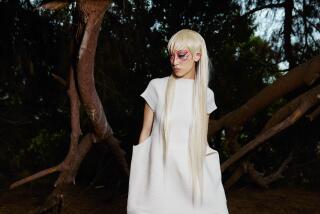AROUND HOME : Japanese Kimonos
- Share via
EVEN TODAY, THE kimono plays an important role in Japan and, if it is not used as extensively in private life as it once was, it is nevertheless found regularly at ceremonies and on stage in theatrical presentations of all kinds.
The materials used, and the designs available, are almost without limit. Except for the cheapest mass-produced version, almost every kimono--certainly those made in the past--is one of a kind. Even in its simplest form, it is a work of art, because, in Japan, there has never been any distinction made between fine art and applied art. As is the case with so many other products of every-day Japanese life, a consistent effort has been made to find beauty ( utsukushisa ) and to create the most decorative effect possible. Design is intended for everyone; it is something that can make the daily lives of ordinary people beautiful and rich in imagery. The most highly praised designs are often those sketched with the simplest of materials. So it is with the kimono, found today and yesterday in three different areas: the private, the ceremonial and the theatrical.
In the private area, there are many examples from the Edo period (1603-1867) available to the collector. Consider, for example, long silk over-kimonos from the late Edo period with abstract (as well as realistic) designs of flowers, birds and landscapes. There are simple designs, too, such as the typical summer kimono for men, made of white linen with a fine dyed-in-the-yarn pattern. Tied with a broad sash slung low on the hips and with a fan slipped under the knot, it is the traditional masculine wear. In addition, the lovely Kazuki (outer kimono) is overgarment worn like an all-enveloping veil by women and girls of all ages.
The kimono is used today for important rituals and ceremonies. Elegant black robes, for example, are for funerals. Department stores have special consultants who arrange beautiful wedding ceremonies with the emphasis on complicated hair styles and gorgeous, elaborate kimonos.
In the theater, too, the kimono today serves, as it has always served, as a costume, simple or extravagant as the occasion requires. Consider the striking noh costumes made in the last century, featuring bold cherry blossom designs arranged on a crimson background of gold and silver embroidery with leaves in gold and silver stitchery. the costumes used for the Kabuki theater are even more striking, and brilliant colors such as purple, red or orange and wild designs are thought to increase the drama of the performance.
Today, prices for antique kimonos and theater costumes range from a few hundred dollars to many thousands, depending upon how old the garments are and what materials are used. In the proper setting the kimono can be hung as if it were a painting; there is certainly no question that it is a work of art.
Look for Japanese kimonos at Larchmont Japanese Antiques and McMullen’s Japanese Antiques in Los Angeles; I.M. Chait in Santa Monica; The Gallery in Palos Verdes Estates; Okame Arts in Pasadena; S & F Jackson in San Diego; Oriental Arts in Coronado.
More to Read
Sign up for Essential California
The most important California stories and recommendations in your inbox every morning.
You may occasionally receive promotional content from the Los Angeles Times.













